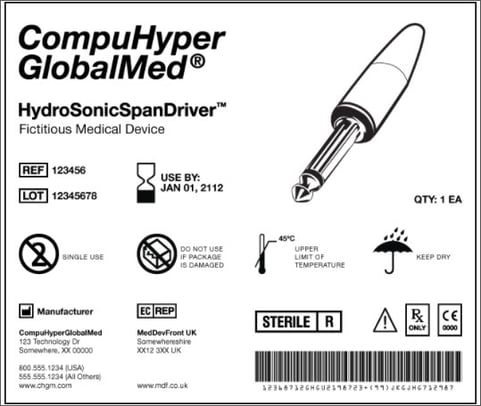Unique Device Identifier (UDI) Fundamentals
What is the UDI?
The “unique device identifier” is an alpha-numeric code assigned by an FDA-accredited issuing agency (or, in the absence of such an agency, by the FDA) that allows the healthcare community and patients to access basic identifying information about a specific version or model of a medical device. The UDI information is required to be in both a plain-text format and a second format that can be read by automatic identification and data capture (AIDC) technology, such as a bar code, RFID tag, or near field communications (NFC).
The UDI consists of two parts: the device identifier and the production identifier. The device identifier is essentially static information. It includes the specific model or version of the device, and the name and contact information of the labeler (usually, the manufacturer). The production identifier contains specific manufacturing information. It includes, among several other items, the lot or batch number, expiration date, date of manufacture, and if the product is sterile.
The FDA provided this example of a UDI label:

Benefits
The FDA listed the benefits of the UDI program as:
- More accurate reporting, reviewing, and analyzing adverse events leading to faster corrective actions
- Reduced medical errors through more rapid and precise identification of a device
- Consistency in how medical devices are referenced in electronic health records
- More effective management of recalls through standardized identifiers
- A foundation for a secure global distribution chain that will help address counterfeiting, diversion, and emergencies
UDI Requirements
The UDI must be on both the device label and the package in which the device is distributed. When a multiple-use device is likely to be separated from its label, the device itself must be marked with the UDI. In addition, there are three other categories of devices that require UDIs to be marked directly on the device itself:
- Implantable devices for use longer than 30 days
- Devices intended for sterilization and reuse
- Stand-alone software (here, the UDI should display upon start-up)
The Agency has carved out some exceptions within these categories, however, including bone cement, devices where the capital investment would be too great relative to the benefit of the UDI, and devices sold at retail.
The "Labeler"
With the new UDI rules, the FDA also gives us a new definition: “labeler.” In this context, a labeler is any person who causes a label to be applied or modified on a device with the intent that the device will be introduced into U.S. commerce without any subsequent replacement or modification of the label. It is the labeler’s responsibility to assure compliance with the UDI rules and maintain all records linking the device to its UDI.
The labeler will most often be the manufacturer, but could also be the specifications developer, reprocessors, convenience kit assemblers, repackagers, or relabelers.
Special Considerations
Makers of combination products, convenience kits, and “multi” packs should be aware of special considerations affecting those products. For combination products, the primary “mode of action” is what determines whether the product requires a UDI. If the product is primarily a device mode of action, a UDI is required. If instead it is primarily a drug mode of action, the combination product itself does not need to be labeled with a UDI, but any device constituent would require a UDI. For convenience kits, if the kit contains service components, both the components and the kit require distinct UDIs. Finally, as mentioned above, for “multi packs” in which multiple devices are sold together within one package, both the package and each individual device within the package must bear a UDI.
Exceptions
Though far-reaching, the UDI rule is not absolute across the device industry. There are several categories of products that may not require a UDI, including:
- OTC devices sold at retail or to healthcare facilities
- Class I devices that are already exempt from the quality system requirements
- Individual Class I single-use devices distributed together in a single package that have generally known uses (e.g., adhesive bandages, patient examination gloves)
- Devices used solely for research, teaching, or chemical analysis
- Custom devices
- Investigational devices
- Devices not intended for export
- Devices held by Strategic National Stockpile
Global UDI Database
The proposed rule establishes a Global UDI Database (GUDID), which would be an FDA-administered, publicly accessible database tracking all medical devices’ UDIs, including those that are no longer on the market. The labeler will be responsible for submitting the appropriate information to the GUDID.
This information to be provided includes, but is not limited to:
- The device identifier portion of the UDI
- Any previous UDIs associated with the device
- Devices with direct markings UDIs
- Proprietary, trade, or brand names of the device
Timeline for Implementation
The finalized UDI rule was published on September 24, 2013. All Class III medical devices had to have a UDI one year after publication of the final rule, and data for those devices was required to be submitted to the GUDID database at that time. Class II devices must have a UDI three years after publication, and data on those devices also must be submitted to the GUDID then.
The schedule for implementation is as follows:
Immediately upon publication of final rule:
- Requests for an exception or alternative to UDI labeling requirements may be submitted (§ 801)
One year after publication (September 24, 2014):
- Dates on medical device labels must be formatted as required by § 801.18
- Class III medical devices and devices licensed under the PHS Act must bear a UDI.
- Data for Class III devices and devices licensed under the PHS Act must be submitted to the GUDID database.
Two years after publication (September 24, 2015):
- Implantable, life-supporting, and life-sustaining devices that are not Class III devices or licensed under the PHS Act must bear a UDI.
- Data for implantable, life-supporting, and life-sustaining devices that are not class III devices or licensed under the PHS Act and that are required to be labeled with a UDI, must be submitted to the GUDID data base.
- All implantable devices required to be labeled with a UDI must bear a UDI as a permanent marking on the device itself.
Three years after publication (September 24, 2016):
- Class II medical devices must bear a UDI.
- Class III devices required to be labeled with a UDI must bear a UDI as a permanent marking on the device itself if the device is 1) intended to be used more than once and intended to be sterilized before each use, or 2) stand-alone software regulated as a medical device.
- Data for Class II devices that are required to be labeled with a UDI must be submitted to the GUDID database.
Five years after publication (September 26, 2018):
- Class I medical devices and devices that have not been classified into Class I, Class II, or Class III must bear a UDI.
(This information is available on FDA’s website in the “Proposed Effective Dates” table)
Conclusion
Device firms would be wise to start addressing its requirements now to ensure adequate preparation for the rule’s various compliance stages.
For additional resources contact the Marketing department
Phone: 888-633-6272
Medmarc is a member of ProAssurance Group, a family of specialty liability insurance companies. The product material is for informational purposes only. In the event any of the information presented conflicts with the terms and conditions of any policy of insurance offered from ProAssurance, its subsidiaries, and its affiliates, the terms and conditions of the actual policy will apply.
Copyright © 2024 - Medmarc
